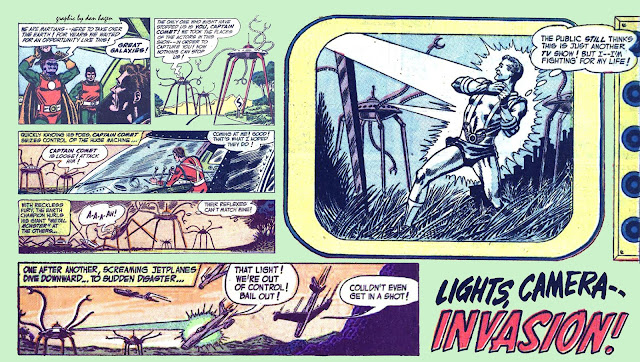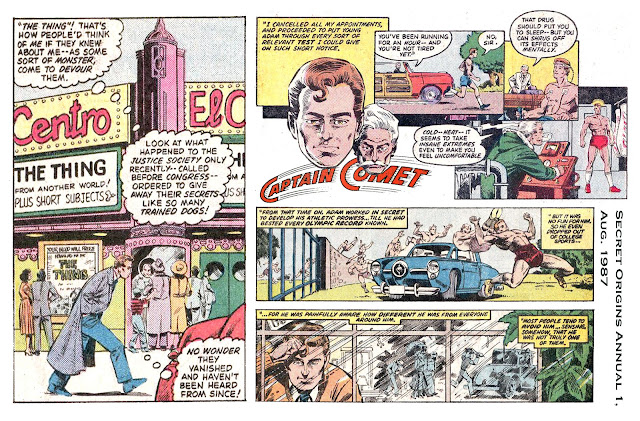April 1953: The Second War of the Worlds
Instead of seeing nonexistent menaces
that no one else can see, as he had in his last adventure, Captain Comet
becomes the first person to recognize the actual threat that the nation is
calmly watching on the newly popular medium of television.
Already legendary in 1953, Orson
Welles’ newscast-style radio adaptation of H.G. Wells’ 1897 novel War of the Worlds had sparked a national
panic on Halloween in 1938. In Lights,
Camera — Invasion! (Strange
Adventures 31, April 1953), a live teleplay of War of the Worlds is used as a cover for an actual alien invasion.
“All over the nation people
waited expectantly for Captain Comet’s first television appearance — in a
coast-to-coast telecast of an interplanetary drama!” the story’s cover page
announced.
Live TV drama was common during
the “Golden Age of Television” from 1947 to 1957. In fact, on Sept. 9, 1957, CBS’s
Studio One aired The Night America Trembled, a top-rated television recreation of
Orson Welles' radio broadcast of The War
of the Worlds on October 30, 1938 — the very premise of this Captain Comet
story.
For whatever odd reason, the
superhero has agreed to appear as an actor in the teleplay, which begins with
an announcer saying, “Folks, 15 years ago this play caused widespread panic!
Therefore, we want to make it clear that the drama you are about to see is
imaginary — designed only to entertain you!”
The program cuts to a pseudo-news
report of a spaceship landing in New Jersey, and video of giant alien war
machines on the move.
“This show is so realistic — it’s
got me half-believing it,” Captain
Comet thinks as he dashes out to confront the machines for the cameras. But
he’s overcome by a “puff of queer, greenish smoke,” and tentacles haul his limp
body into one of the machines.
“We decided to change the script,
Captain Comet!” explains one of the purple-faced humanoids in the machine. “We
are Martians — here to take over the Earth! For years we waited for an
opportunity like this!”
“Great Galaxies!” exclaims the
superhero, as well he might.
“The only one who might have
stopped us is you, Captain Comet! We
took the places of the actors in this show — in order to capture you! Now
nothing can stop us!”
When the military finally figures
out what’s going on and sends in jet fighters, they’re knocked out of the sky
by Martian ray beams. But the Martians make a mistake when they turn their heat
rays on their super-prisoner.
“The cords binding me are
melting!” the Man of Destiny thinks. “But they still haven’t reached a
temperature that can hurt me!”
Snapping his bonds, Captain Comet
overpowers his former captors and seizes the controls of the war machine. “Their
reflexes can’t match mine!” he thinks.
Although this adventure is even
less plausible than usual, it’s fun to see Murphy Anderson put Captain Comet at
the controls of one of Wells’ famous giant Martian fighting machines, waging
war against the others.
A poignant variation on the theme
would be provided in 1998 by artist Michael Lark and Roy Thomas in the DC Elseworlds graphic novel Superman:
War of the Worlds.
At the end of the story, Lily
Torrence, seeing Captain Comet for the first time on television, remarks to
Adam Blake that they look awfully similar. Blake tries to cover up in that
feeble Clark Kent manner — “Oh, it’s, er, just your imagination, Miss
Torrence!”
But he hardly need have bothered,
as we’ll see in his next adventure.




Comments
Post a Comment